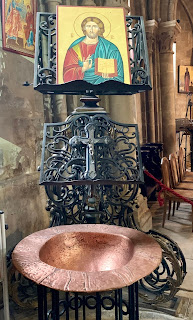We enjoy walking tours. Here in Paris, we taken several, including multiple tours of the Île de la Cité, once on our own and thrice with guests.
The Île de la Cité is one of the islands in the Seine in the heart of Paris. The island, filled with history, is among the oldest parts of Paris.
Let's start walking.
Each time we toured, we started on the Left Bank at Odette, a pastry shop that specializes in choux à la crème (cream puffs). Some people think Odette makes the best cream puff in Paris. We agree. What a delicious way to start a walking tour -- the tour company chose a great meet-up spot.
Next to Odette is one of the oldest churches in Paris, the Église Saint-Julien-le-Pauvre. A church has probably existed on the site since the 500's. The current church (pictured below) was built in the Romanesque style during the 1100's and 1200's.
Next to Odette is one of the oldest churches in Paris, the Église Saint-Julien-le-Pauvre. A church has probably existed on the site since the 500's. The current church (pictured below) was built in the Romanesque style during the 1100's and 1200's.
While viewing the church, we spotted something odd. The window pictured below was once Romanesque with a round arch but was later changed to a Gothic window with a pointed arch.
Today, Église Saint-Julien-le-Pauvre. is home to a Melkite Greek Catholic congregation.
The church's name, Saint-Julien-le-Pauvre (Saint Julian the Poor), is based on the legend of 7th-century Saint Julien the Hospitalier, who worked as a ferryman and cared for the poor. Near the church is a relief (pictured below) that represents an episode from Julian's life. When no one else would, Julia n ferried a leper covered with sores across a river. Julian fed and clothed the leper. Like the beggar in the story of Saint Martin, the leper turned out to be someone else.
Next to Église Saint-Julien-le-Pauvre is a public square, Square René Viviani, that offers a nice view of the cathedral, Notre-Dame de Paris. The square is named for a former Prime Minister of France.
 |
| Melinda and Marie-Chantal |
The square is home to the oldest tree in Paris, planted about 1601. The 400+ year old tree was damaged by a WWI shell but survived and thrived.

The tour continues by crossing the Seine onto the Île de la Cité to get as close as we can to Notre-Dame de Paris. Since the April 15, 2019 fire, barriers prevent visitors from getting very close. Still, the cathedral is immense and therefore easily appreciated, even from a distance.
Our guides talked about the cathedral's long history, its importance in France and the devastating fire that destroyed the cathedral's ancient wooden roof and the 19th century spire, among other things.
 |
| Saint Denis |
In the two photos below (from January 2020), you can the current state of restoration. A temporary roof has been built. The windows have been removed and wooden braces support the buttresses. The crane was recently installed. Workers will be suspended from crane to start removal of the scaffolding that was in place before the fire.
 |
After walking around the cathedral, we explored other parts of the Île de la Cité.
Below, you can see the narrowest street on the island, Rue des Chantres. Most streets in medieval times were very narrow. Over time, streets were widened to accommodate modern life. The street below is narrow but has enough for a small car to pass.
 |
| One of our guides, Josquin |
We also visited the Maison de la Colombe. The 13th century legend goes like this: The house collapsed and two doves were trapped inside. The male escaped but returned to bring bits of food and water to his partner, the female. After several days passed, the female also escaped and the two doves flew away together. Happy ending. Even today, this "dove house" is known as a place where true love triumphs. Many brides and grooms come there to have wedding photos taken.
We also visited another house with a love story, a 12th century home where Heloise and the much older Abelard met. Their legend is somewhat more complicated. Abelard, a famous professor and philosopher, becomes Heloise's tutor. They fall in love, Heloise becomes pregnant. They flee Paris and marry. The child is born and given to a relative. Heloise is sent to a convent. Heloise's father finds Abelard and castrates him. Heloise, now a nun, and Abelard, now a monk, live the rest of their lives apart. Their undying passion is expressed in ardent love letters. They never see each other again. However, they are reunited in death, eventually being buried next to each in Père-Lachaise cemetery in Paris.
Abelard and Heloise
Thanks for touring the Île de la Cité with us.




























No comments:
Post a Comment